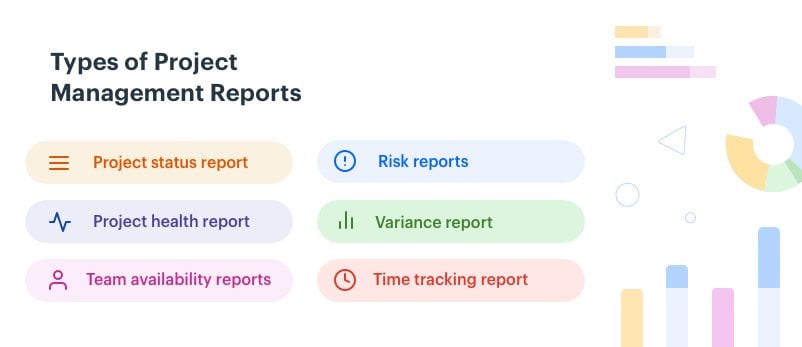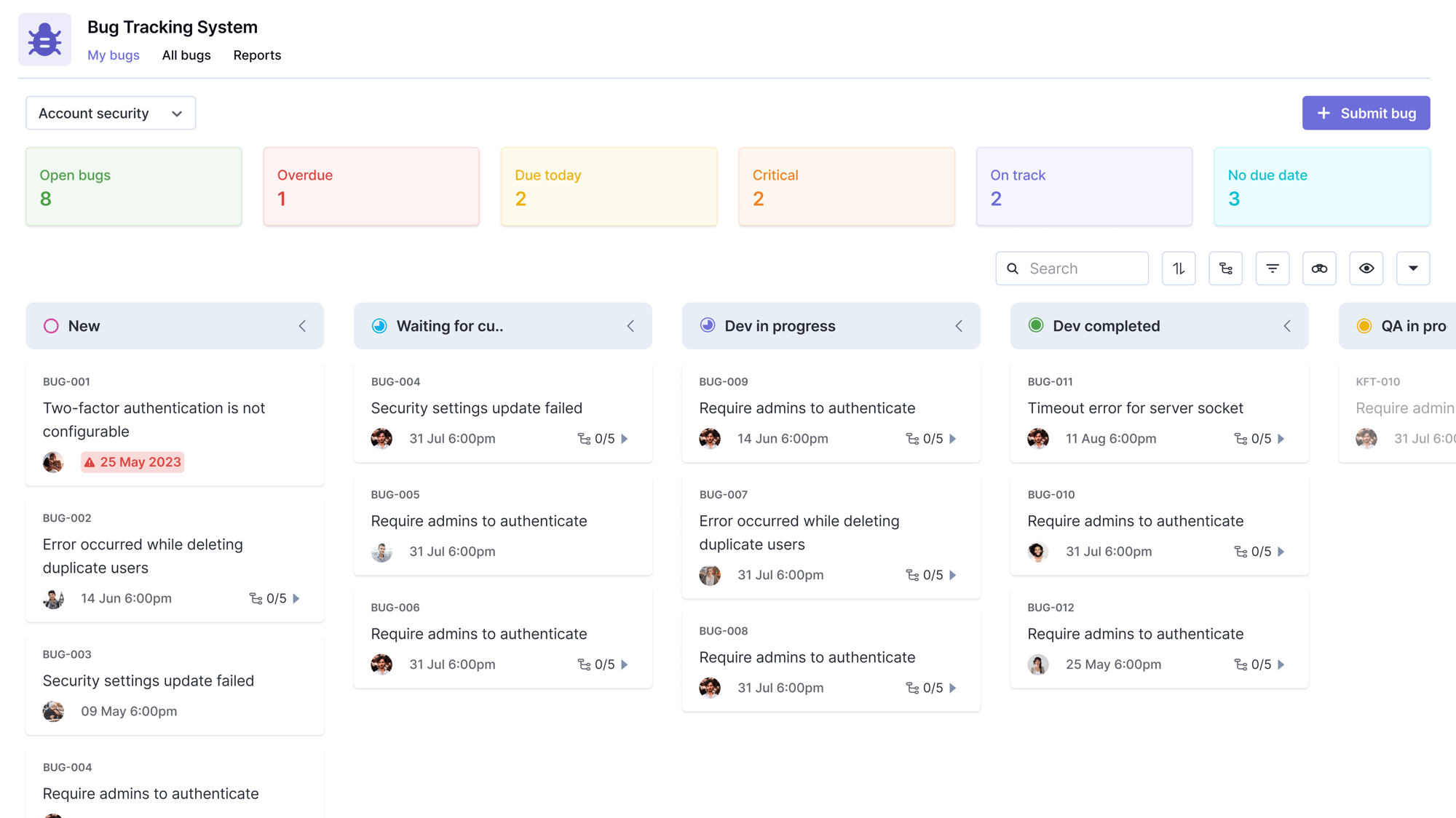In between the to-do and lines, a lot of tracking, measuring metrics, and analyzing trends go into making sure a project is completed successfully, on time, and under budget. So, as a project manager, how do you make sense of all that data?
Project reporting is how you do it.
What is project reporting?
Reporting in project management simply refers to providing a high-level overview that offers the critical data the project generates in a simple, easy-to-use format. Project reporting is essential to project management success since it provides a window into what’s happening and what to do about it for the entire team.
Project management tools with reporting features help manage projects better with simpler, smarter project reporting.
Why is project reporting essential to project management?
Without adequate project management reports, the project team and project stakeholders end up being in the dark, unable to put their finger on what’s going on with the project. As a result, it’s all too easy for the project to fail, simply because the right insights aren’t getting through and therefore, appropriate decisions aren’t being taken.
Project reporting fulfills the need for information in the project management process so that data is taken from where it’s generated, and delivered to where it’s interpreted and applied.
Overall, project management reports are important because it:
- Shows the project team what they are working, so they can explain why it’s working and focus more on it.
- Uncovers what’s not working so the team can investigate and determine an appropriate course of action i.e. what to do about it with the help of the project dashboard.
- Gives the team a 360° overview of how the project is doing so they can determine what steps to take next.
The different types of project management reports
Below is a collection of the reports you’ll need to manage your projects and what valuable insights each of them provides.

1. Project status report
The project status report is a critical report that shows stakeholders a general snapshot of how well the project is advancing toward its targets. The project status report can be thought of as a general update that’s designed to keep stakeholders or project progress, emerging issues, and key points to note, all at a glance.
You can kickstart by creating a project status report by signing up with Kissflow Project for free.
See how Kissflow delivers the fastest time-to-value in the market
2. Project health report
Project health reports are designed to update stakeholders on the overall health of the project, derived from whether the project is either advancing as projected, in danger of stagnating or completely stagnated.
Why you need project health reports:
The project health report answers the following questions:
- Are we on track to deliver this project on target? Have we stagnated?
- How far off are we from the target?
- What needs the most attention to get us back on track?
Project health reports make it easy to identify when something’s wrong so the team can identify what and get it out of the way.
How Kissflow's low-code platform helps you achieve faster time-to-market
3. Team availability reports
The team availability report functions like a team calendar that shows every team member’s schedule so it’s easy to see who’s occupied and when they are busy. This way, stakeholders who are planning for a project or requiring input anywhere can see which team members can be assigned, those who can safely take on more work, as well as those who are at full capacity and might need assistance.
Why you need team availability reports:
- Availability reports make it easy to visualize how much everyone has on their plates so work can be more evenly distributed to achieve faster results, higher efficiency, and most importantly, prevent project burnout between teams.
- An availability report plots staff names against calendar days, with either a color tone or a written designation showing their workload for each calendar day.
4. Risk reports
A risk report identifies the blockers hindering a project’s successful completion and presents it for the stakeholders’ analysis. The risk report is designed to not only display existing or potential obstacles but to offer a sense of the danger they pose to the project so the project’s stakeholders can take adequate steps to eliminate project risks or adapt the project.
Why you need risk reports:
Project risk reporting helps the project team to:
- Determine existing and potential project constraints that are already holding back the project, or that will hold it back
- Visualize obstacles on a risk scale to determine which ones to prioritize
- Determine how to keep future projects from running into similar hitches
Embrace Efficiency with Kissflow Project - Join Thousands of Project Managers!
5. Variance report
It’s quite common for teams to deviate from the project’s key targets without even knowing. In the end, this results in project failure after time and resources have been expended.
A variance report helps the project team and stakeholders to ensure that doesn’t happen. You can track the target project milestones and objectives of the project along with the work that’s getting done.
Why you need variance reports:
With a variance report, the team can see if the work they’re getting done is actually the project’s targets or whether they’re just spending time without ticking off the following,
6. Time tracking report
Project time tracking helps the project team & stakeholders see how much time is getting spent by team members at every stage of the project management process. A time tracking report helps the team to see how much time overall is spent on specific tasks and how much individual team members spend on tasks.
Why you need time tracking reports:
- Time tracking reports help in assigning team members to tasks where they’re more efficient,
- Tracking time spent on tasks for compensation,
- as well as optimizing systems and processes so work gets done faster.

Struggling to pick the perfect project tool?
A comprehensive guide to help in your search
Read for FreeHow to create effective project reports
The aim of project reporting is to offer all the information generated from your projects in a simple format so stakeholders can understand and apply those insights. Here are some best practices that’ll help you create reports that actually enable project stakeholders to make informed decisions.
1. Keep data at the center
The aim of project management reports is to deliver processed data to those who need it so they can be informed and make appropriate decisions from it. It’s important that reports present solid data that stakeholders can look at and get an idea of the big picture.
2. Visualize the data
Apply an abundance of images, charts, and graphs wherever appropriate to fully illustrate the implications of whatever data you present with the help of visual project management tools.
3. Leave the stage open for constructive communication
Reports shouldn’t be full stops that spit out data and get over with it, rather reports should try to explain the data and its implications while inviting further questions. It might be demanding but this ensures that project collaboration between stakeholders are on the same page and get a full picture of what you’re trying to convey.
4. Create reports appropriate for your audience
Senior-level management won’t have the time to sift through small details; team members won’t be able to make much out of a report that shows only a few figures, project management charts, and notes. Reports must be adapted to the needs of your specific audience so they get all the information they need through project communication management, without getting bogged down or left in the dark with incomplete data.
How Kissflow Project helps with project reporting
Managing your projects with Kissflow Project gives you an immense edge over the competition and makes it infinitely easy to get work done as opposed to spending hours jumping through your project management software or slowly entering figures one-by-one on spreadsheets.
Kissflow Project, not only helps you create stunning reports easily but takes all your data and puts them in an easy-to-use format with just the click of a button.
Take Kissflow Project for a spin today and simplify your project reporting. Signup for free now.

%20(2).png?width=2000&name=PSE%20Dashboard%20(3)%20(2).png)
.png?width=2000&name=Dashboard%20(5).png)


